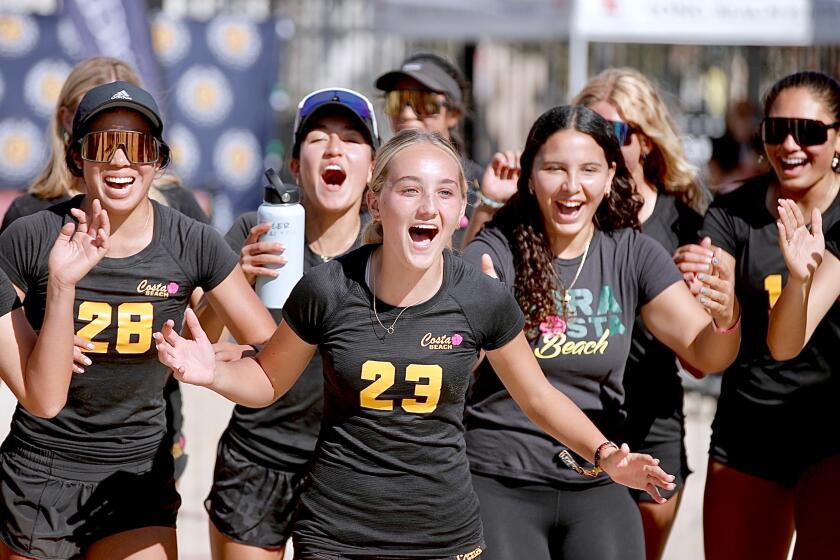Debate heats up for public and private schools
Jim Kunau became the football coach at Orange Lutheran in 1993 and eyed public schools to fill out his team’s schedule. Most would have routed Lutheran on the field back then, so they refused to play the Lancers because they had nothing to gain.
Over the last two seasons, Lutheran has become one of the dominant programs in the Southland. It won the State Division II Bowl Championship game two seasons ago and reached the Southern Section Division I semifinals this season.
In the 2 1/2 months since the football season ended, seven players -- four from public schools -- have transferred to Lutheran. The Lancers are this month’s poster boys for the debate between public and private schools that should be spirited when a controversial proposal is presented for the first time Thursday before the Southern Section Council. The proposal by the Century League will be made by Jerry Halpin, principal at Brea Olinda, a public school best known for its girls’ basketball team that has won eight state titles. It will request that private schools in all team sports be moved into separate playoff divisions.
Based on a copy of the proposal received by The Times, Halpin will contend that private schools have no attendance boundaries and can be selective in choosing their students and that they have greater flexibility in how they use their financial resources, which can be funneled into salaries for coaches and specialists as well as facilities.
“A fair number of schools in North County have been impacted by private schools,” said Villa Park Athletic Director Tom Fox, “especially in the last five years.”
In other words, since the rise of Orange Lutheran.
“I don’t want to harp on just one school,” said Fox, who has also been an athletic director at Santa Fe Springs St. Paul, a private school. “My phone has been blowing up from calls with athletic directors and coaches from all over the section.”
“Among the public school athletic directors, I haven’t heard from anyone who is against” the proposal, Fox said.
Magnet and Charter schools are public schools that don’t have attendance boundaries either. Some districts have open enrollment. In Long Beach, for example, the top football and basketball players usually go to Poly, the best water polo players to Wilson and the baseball players to Lakewood.
Yet Kunau says he needs to look no further than the Century League to turn back the argument.
“The biggest issue that affects competitive advantage is the quality of the coaching staffs,” he said. “Did El Dorado suddenly become a different school the last three or four years? Is that why they’re 26-2 the last two seasons under Jeff Bailey? They didn’t suddenly switch from being a public school to a private school.”
El Dorado Athletic Director Carl Sweet, though, says he worries that a private school might hire away Bailey with an offer that can’t be matched.
Ronnie Carter, executive director of the Tennessee Secondary School Athletic Assn., has seen this debate before. He oversees separate playoffs for public and private schools that do not offer financial aid, and private schools that do offer financial aid.
“When you cut to the chase, it’s about winning,” Carter said. “Everybody wants to be in a position to win, and if there’s people that are keeping me from winning, then I want you out of here.
“It’s societal. Instead of lining up to find out how to beat you, I’m going to find a way to get you out of my league, so I don’t have to contend with you.”
“That’s pretty accurate,” said Rick Strunk, associate executive director of the North Carolina High School Athletic Assn. He hears in his state the same complaints being aired this week in Southern California. “I do think we wouldn’t be hearing that much about it if those teams weren’t winning.”
But are they? The perception is yes.
However, according to the Southern Section office, public schools compose 62% of its membership and have won 61% of all team championships from fall 1996 through fall 2007.
Of the total titles won by private schools, 48% of the private schools have accounted for 100% of championships; 18% of the schools accounted for 71% of the titles; 7% have accounted for 44% of the championships.
These proportional findings present a problem for Jim Staunton, section commissioner, who was told by legal counsel that should litigation arise, the section “would be obligated in the eyes of the court to show a rational basis for making this decision,” he said. He doesn’t know that one exists.
He is also concerned about the emotional fallout.
“I don’t want to add to the divisiveness that’s out there,” Staunton said. “I don’t want to see a wedge being driven between our schools.”
Yet that figures to be the case if the proposal eventually passes, according to some coaches.
“You’ve created more friction and a competitive atmosphere,” said Santa Ana Mater Dei football Coach Bruce Rollinson, who wondered whether separate playoffs wouldn’t unite private schools to choose to break away from the Southern Section.
“If that happens, we’ll get our own sponsorships and our own TV coverage,” he said. “Now the student-athlete says, ‘Do I want to be in the private school section or the public school section? Which one has better sponsorship, better media exposure, who plays in front of bigger crowds and is more attractive to me?’ ”
If the Century League’s proposal were eventually approved by council vote, Staunton said he would recommend it take effect in the 2010-11 school year. Dave White, who played football for Huntington Beach Edison and has been the Chargers coach for years, said he doesn’t know whether he likes the proposal. Since adding private schools to his nonleague schedule, his team has won five of the last seven Sunset League titles and been to the marquee division’s championship twice.
“I have a lot of public school coaches that are mad at me because I play Mater Dei and Servite,” White said. “They want to shut them out. They say the only way we’re going to change things is if we don’t play them.
“I’m selfish. I’ve got to improve my program [because] I’ve got to play them in the playoffs. We had to work harder. It was sink or swim. And we worked harder.”
--
Get our high school sports newsletter
Prep Rally is devoted to the SoCal high school sports experience, bringing you scores, stories and a behind-the-scenes look at what makes prep sports so popular.
You may occasionally receive promotional content from the Los Angeles Times.



